Android L, Nexus 5, Google Search and all-all-all
Hi, Habr! While lovers of fruit devices are measured by shovels and missing / delayed features, and Siri still does not know how to speak Russian, we can enjoy the progress of another OS and its services. Under the cut, you can find out what makes Android L look different from 4.4.4, what resources it requires for work, what to expect from devices that will receive an update. Well, a little more talk about the voice search, which not so long ago received several significant updates, but they were somehow past Habr. All the tricks in this post are performed by professional smartphones, repeat at home at your own peril and risk.

Actually, we will be comparing two different generations of Android on Nexus 4 and Nexus 5. Both are released by LG and have quite good characteristics. If anyone has forgotten that inside smartphones is responsible for performance - here is a sign.
')
As you can see, the glands differ by one generation (formally by one and a half, because there is a Snapdragon 600, which is an improved APQ8064 with slightly higher frequencies of CPU and GPU + native support for OpenGL ES 3.0), and the difference in performance is quite noticeable.

Test results from left to right: Nexus 5, Nexus 4, LG G2.
The final numbers of the Nexus 5 and Nexus 4 benchmarks differ by almost a third: differences in frequency, and a much more advanced GPU, also affect it. How it affects the final performance of the system - we will see later. By the way, modern Snapdragon 400 issues 18-19 thousand to Antutu, and yet they are put on fairly inexpensive devices (the same Motorola Moto G). Here's your proof .
The competitors will be Android 4.4.x KitKat and not yet named Android L. Did Google promise increased performance and increased battery life at the same time? So check it out. In addition to the updated system design, they differ in the main environment in which all programs are executed: before Android L, the system has a Dalvik virtual machine installed by default, you can manually select the ART environment and test, after Dalvik there is no more, and the only available system is new ART. If anyone is interested in real numbers of the changed performance, energy saving and other mathematics, then Adnroid Police has excellent material in three parts: 1 , 2 , 3 , everything is explained in detail in it. For the purity of the experiment, both systems will work with ART: so it will be noticeable whether Android L influences, or all the merits in terms of the increase in performance will go to ART itself.
As for the design of the system ... Google's new style of OS is called Material and looks much more pleasant and modern than the grimness of Android 3-4.x, which prevailed in smartphones and tablets from mid-2011 to the beginning of 2012. Then, of course, the design seemed interesting, but in two years the trends have changed, and the new, visually cleaner design is a real breath of fresh air.
In the case of the Nexus 4, everything is quite simple: it rushes easily, custom recovery is installed without problems, there are enough ready-made Android L assemblies on the XDA. I will not give specific references to all of this: who knows how to do this, where to click, and how a drawing tool will find everything better than me. Who does not know - it is better not to meddle without educational program, if you want to try, start reading "what and in what order" is here (open the third spoiler in the first post and study the topic).
In the case of the Nexus 5, things are more complicated. Detailed instructions for installing the official assembly of Android L on the top five are at w3bsit3-dns.com, but, unfortunately, it has links to some of the downloaded materials that are broken. Download the necessary (as well as get English instructions) here , for example.
Separately, I want to note: you yourself take all the risks. Responsibility for damage to your information, your device, its warranty service and the aliens from Alpha Centauri is your responsibility. Neither the author of the post, nor the author of the instructions, nor Google itself is responsible for the wrong Gauss Curvature coefficient of your hands.
The performance of the OS itself is difficult to measure: benchmarks will show a very relative result, moreover, they may differ from measurement to measurement. In an amicable way, it is necessary to observe all lab conditions, that is, to have two devices of each type, place them in identical conditions, carry out a complete cleaning of everything-what-can-and-what-is-impossible, and, on a clean system, ten times, at regular intervals measure the performance of Android 4.4.4 VS Android L, and then swap the OS and perform as many tests to make sure that specific instances of devices do not introduce an error in the measurements. Unfortunately, neither two identical devices, nor such a large amount of personal time yet.
With autonomy, by the way, the same trouble. For this reason, we will measure by the method subjectively: the average wizard case changes little during the week, the quantity and quality of smartphone use by the body is also very constant, so one week with Adnroid 4.4.4, one with Android L, a summary table and the results in it.
Both smartphones were removed from charging at the same time (8 am), both got up at the same time (1 am), each smartphone was used all day as the main and only one. I went with Nexus 4, my favorite woman - with Nexus 5.
The table shows the remaining percentages of charge for the two devices at the time of return to the charger.
Nexus 4:
The average difference was 3.546%, which is not much in absolute terms, but it feels like an extra half hour-hour under load in actual operation.
Nexus 5:
The average difference is 4.472%, if it were not for the failure results on Wednesday (rather, they are connected with a large amount of data transfer over 3G and the imperfection of the test procedure itself), the results would have been even better.
Typical use of Nexus 4: up to 10 minutes of talk per day, 1.5-2 hours of music via a Bluetooth connection, 5-10 frames per camera, 10 hours of connecting to Wi-Fi, 2 hours of data transfer via a mobile network, regular email checking, messaging .
Nexus 5 was used more actively: up to 30 minutes of talking, 2 hours of music over the wire, the same 5-10 frames per camera, 10 hours of Wi-Fi, a couple of hours of Mobile Data, constantly active twitter, mail, messengers.
According to the table it is clear that people are too lazy to work on Friday, and the Nexus 5 has reached the charging state in an empty state, which, in principle, is understandable. For the rest, there is a slight increase in autonomy, which, given the general dampness of the updates, which are not just a public beta, but a developer preview, is already a good thing.
You can measure changes in performance only by eye or by shooting synchronous video. For synchronous video, you need two devices of the same model, I, unfortunately, do not have them. As for the "eye": L works much smoother and more pleasant than 4.4 (on which there are no lags and friezes, but there is no such "fluidity" of the interface either). It’s all because of the reworked animations that were previously just ... missing for the most part. If earlier between “clicked” and “appeared” it took ⅛-¼ seconds, then now these ⅛-¼ seconds are busy animating what “appeared”. As with this, L manages to save battery power as well - a mystery. However, we know the answers to it: optimization and ART.
One of the most interesting features: Google Now cards and updated Google Search with its speech recognition system. She, of course, is not sinless, but much better than Siri or Cortana: they do not understand Russian at all, and it is not known when they will learn. In this race of outsiders, I personally stand at Cortana: Microsoft is much more attentive to the Russian market than Apple, which can be seen on the cards, on the services, and on the user support. In addition, I have to make an important remark: Google Now is a service of "cards" that gives answers to questions (and sometimes it does before the question was asked). In fact, Now itself is the output system for three infrastructures: Google mail, Google search engine and smartphone applications. Therefore, if I am talking about updating Now, this is not only an update of the service itself, but also related products: voice search, integration of applications into the system, and work with email capabilities.
The last and penultimate Google Voice Search updates brought:
“Is that all?” - you ask. Are you a little?
Firstly, now, finally, almost all the commands related to foreign words work perfectly. Now the Search perfectly understands when asked about the value of shares in Russian, about the value of goods or services of certain companies. Not bad recognizes the addresses of sites that you want to open. Understands phrases like “the nearest Radisson hotel”. Unfortunately, the smartphone has a “feature” speak from my heart: if the smartphone’s English locale is set up, and google now communicates with you in Russian, then some of the answers will be in normal English, the second (like a command to set an alarm clock) is the purest Mutko style "Setting alarm for seven hours and forty minutes in the morning." By the way, I designed a bug report, and they told me that they would deal with the problem soon. It's nice that they answer. Moreover, while I was preparing the post, the smartphone stopped responding to me with an indecent accent and now reports that the task has been completed normally, but you cannot throw the words out of the song.
And secondly - the continuation of search queries - a great thing. You can ask the system what it knows about any famous person, and then ask something like “how old is he” or “who is his wife” or “where was he born”. Pronouns will be replaced with the name and surname of the object you are interested in, and in case you incorrectly compiled a request (for example, asked about the age of a person who has already died), the system will give the correct answer and correct it, reporting the dates of life and age at the time of death. The same applies to requests for “wife” and civil marriage, work with some other aspects of the knowledge graph, which collects the search engine for celebrities. Celebrities, judging by all, are any people about whom there is an article in Wikipedia. :) In addition, the continuation of search queries works not only with people: “What time is it in Petrozavodsk?” -> “What kind of weather is there?” - no problem.
Unfortunately, while the capabilities of the system in Russian are somewhat inferior to those in English, especially in the United States. The penetration of IT-infrastructure into various institutions, and the integration of services, and the presence of much more accumulated knowledge and data, which are used for recognition, also has an effect. More often you will use in Russian -> there will be more data -> it will work better -> faster there will be new buns for our language. Well, of course, report errors (menu - send report), this will greatly simplify the work of voice search engineers. Do not neglect the personalization: just a few days of active work with voice assistant and enabled customization significantly improve the recognition of your voice and your speech.
The full list of commands that the system knows in Russian is quite extensive. I translated their English cheat-sheet into Russian (under the spoiler). Update the Google app (also called “search”), test your voice commands and Google Now, tell in the comments about your experience.
And while we come back to Android L. :)
I hope to wait for updates. I really hope that vendors will not hang noodles on their ears, that the hardware capabilities will not allow that the screen is too small or the RAM is too tight. For the user, the Nexus 4 doesn’t differ in speed from the Nexus 5, and the modern Moto G budget on the Snapdragon 400 already “In terms of performance, the last year’s flagship, although they cost a half to two times less. And on Nexus 4, everything works great. Well, there’s still hope for the Android One program, you see, after a couple of years, Android will not even get to the bottom of the device’s “non-update”: not the vendor will be responsible for the updates, but the manufacturer of OS, that is, Google. Learn more about One, we learn September 15 .
Considering more voluminous batteries in modern devices and sharpening for a “green” battery in Android L, we will get a quality update, which was a transition from 2.x to 4.x: the smartphone will work faster, longer, and we will cooperate with pleasant , a fresh and neat interface that did not come from an evolutionary way from 2010, but was drawn from scratch in 2014, taking into account the experience gained and current trends. On many screens, the information density decreased, while the speed and convenience increased: legacy forms trailing from Android 2.x gave way to anew drawn, porridge from small lines turned into neat text input fields and explanations for them. The black-gray-blue theme gave way to simple and pleasant colors, full-color fills and the proper focus of the user's attention. So far, some screens, like settings in the depths of the smartphone, parts of the service information and something else are not redrawn, and look somewhat alien, but as soon as you bump into them in the smartphone - you understand how outdated the moral and physical design 4.x: read text harder to work with the interface is not so ... nice or something. As if after Windows 7 or 8 to get into Vista: yes, no longer XP (Android 2.3), but the obsolescence of the interface and concepts is noticeable to the naked eye. In general, progress is felt, the resources of modern smartphones, even in the budget segment, allow you to work with L without any problems, it is up to the manufacturers and suppliers of chipsets.
PS: a huge post came out, notice typos - write in the LAN. Thank! :)
PPS: now, I feel, fans of the “updated and supported” OS will fly in. Comrades, get out of the 3GS box, turn it on, clear all memory and unlock the registry, and then try to make it work without jailbreak. Yes, the OS update itself is wonderful and wonderful (how many features are there from iOS7 / 8 except for redrawn icons, work on iPhone4? 4S?), But in Android devices besides the OS itself there are Google services, and it is their actual version that is important for working device and applications . You can read about it here .
PPPS: at the request of workers, I inform you that not all applications work perfectly with Android L: almost everything related to root and changing system features will work crookedly / will not work at all. Also some clients of social networks and browsers are playing. The explanation for this is one: this is not a release candidate, not a public or closed beta, but a version for developers so that they can begin to adapt their software for the new OS and look at the new design in action.

Devices
Actually, we will be comparing two different generations of Android on Nexus 4 and Nexus 5. Both are released by LG and have quite good characteristics. If anyone has forgotten that inside smartphones is responsible for performance - here is a sign.
| Model | Nexus 4 | Nexus 5 |
| CPU | Qualcomm Krait APQ8064; 4 cores x 1.5 GHz | Qualcomm Snapdragon 800; 4 cores x 2.3 GHz |
| GPU | Adreno 320 | Adreno 330 |
| Ram | 2 GB LP-DDR3 | 2GB LP-DDR3 |
| Screen | 4.7 inches, 1280x768 | 4.95 inches, 1920x1080 |
')
As you can see, the glands differ by one generation (formally by one and a half, because there is a Snapdragon 600, which is an improved APQ8064 with slightly higher frequencies of CPU and GPU + native support for OpenGL ES 3.0), and the difference in performance is quite noticeable.

Test results from left to right: Nexus 5, Nexus 4, LG G2.
The final numbers of the Nexus 5 and Nexus 4 benchmarks differ by almost a third: differences in frequency, and a much more advanced GPU, also affect it. How it affects the final performance of the system - we will see later. By the way, modern Snapdragon 400 issues 18-19 thousand to Antutu, and yet they are put on fairly inexpensive devices (the same Motorola Moto G). Here's your proof .
Android OS
The competitors will be Android 4.4.x KitKat and not yet named Android L. Did Google promise increased performance and increased battery life at the same time? So check it out. In addition to the updated system design, they differ in the main environment in which all programs are executed: before Android L, the system has a Dalvik virtual machine installed by default, you can manually select the ART environment and test, after Dalvik there is no more, and the only available system is new ART. If anyone is interested in real numbers of the changed performance, energy saving and other mathematics, then Adnroid Police has excellent material in three parts: 1 , 2 , 3 , everything is explained in detail in it. For the purity of the experiment, both systems will work with ART: so it will be noticeable whether Android L influences, or all the merits in terms of the increase in performance will go to ART itself.
As for the design of the system ... Google's new style of OS is called Material and looks much more pleasant and modern than the grimness of Android 3-4.x, which prevailed in smartphones and tablets from mid-2011 to the beginning of 2012. Then, of course, the design seemed interesting, but in two years the trends have changed, and the new, visually cleaner design is a real breath of fresh air.
Hidden text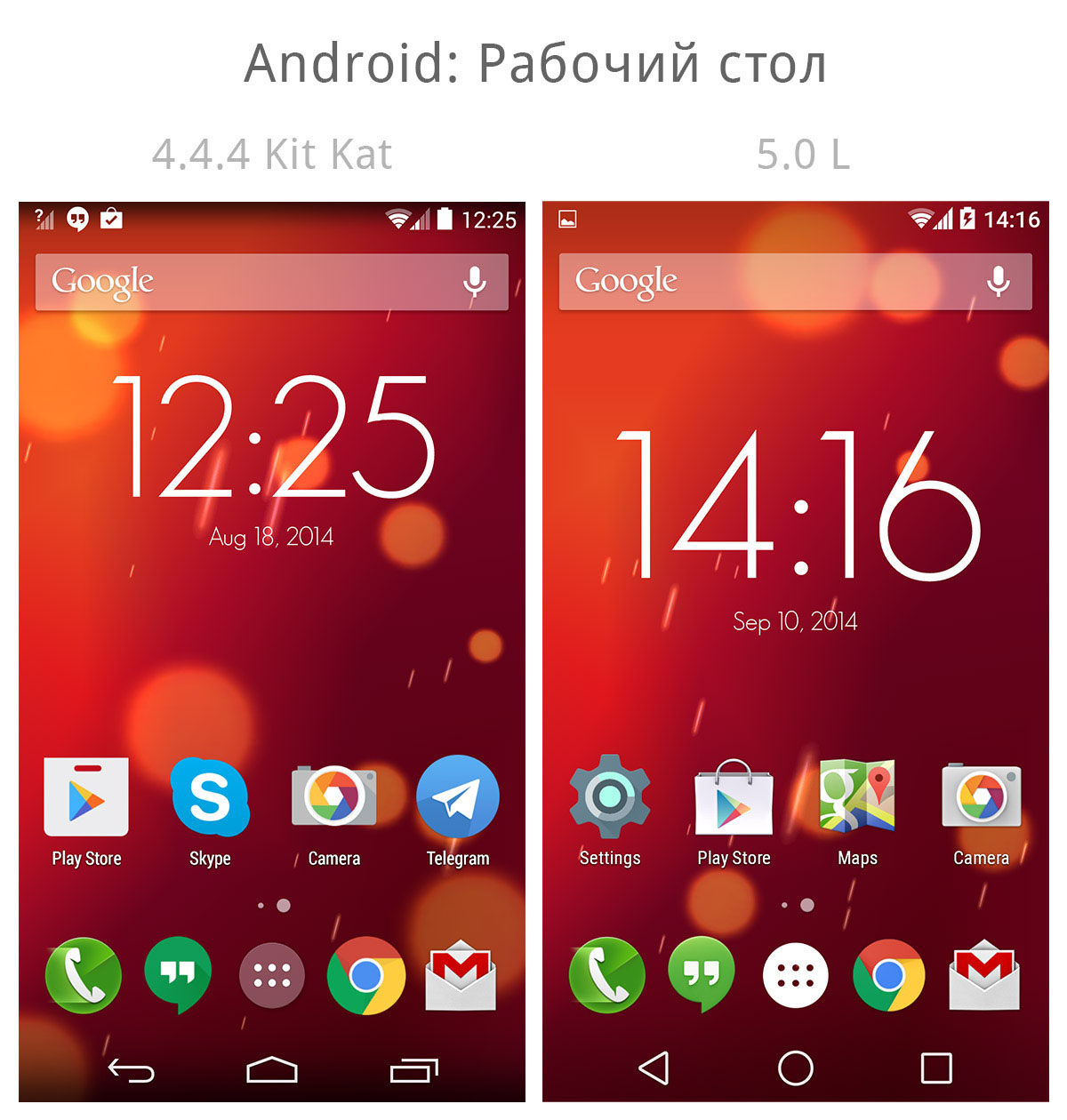
Desktops almost did not change. On the left (4.4) there is a custom set of some icons, the dialer is not native, but 2Gis. Separately, I want to note the new status icons (in the tray, next to the clock). Look and read much better, because become more contrast. The desktop is Google Start . Swipe your desktop right and go to Google Now:
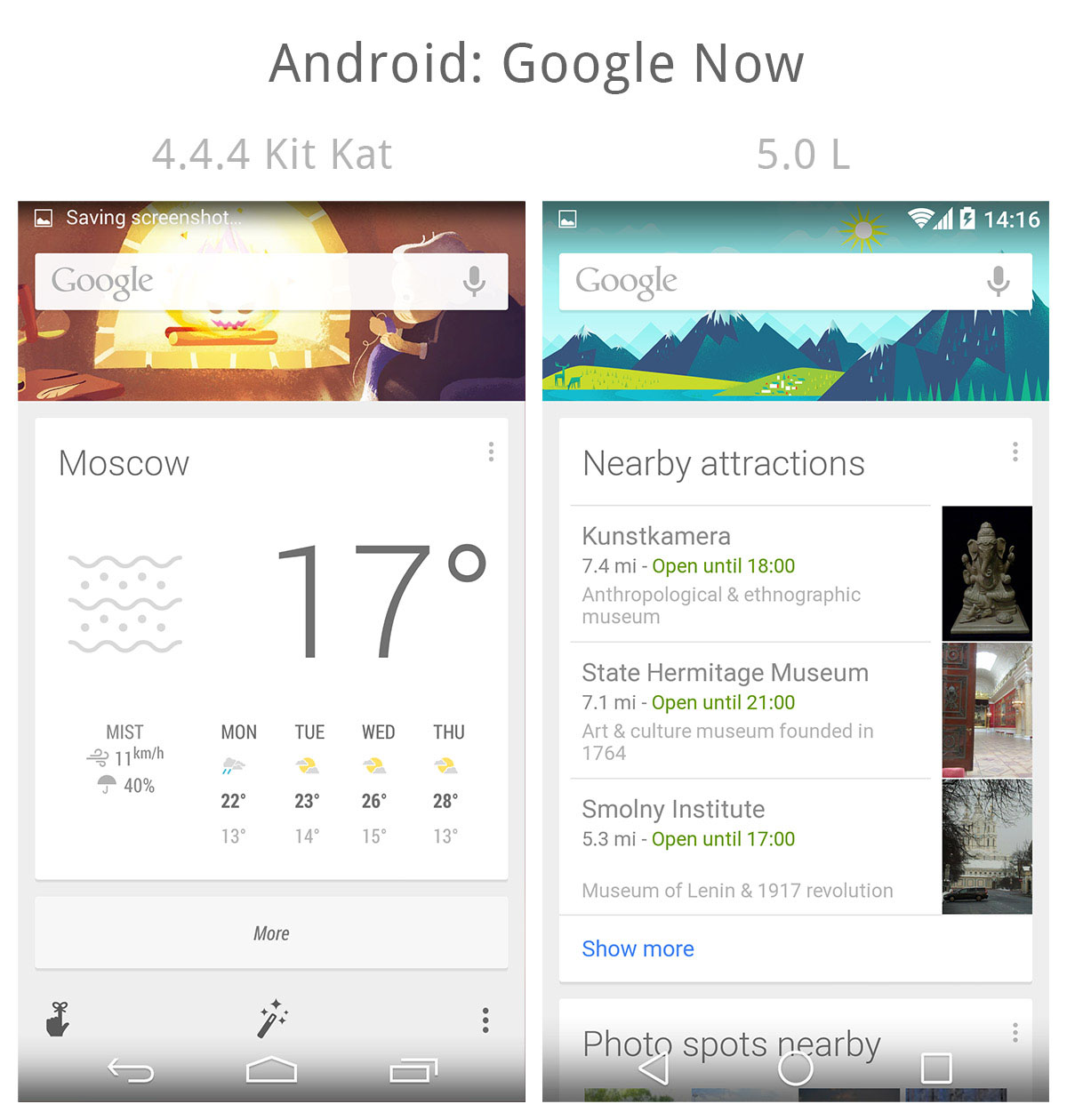
There are no changes, again: it is understandable, this is a separate application and it looks more or less relevant.
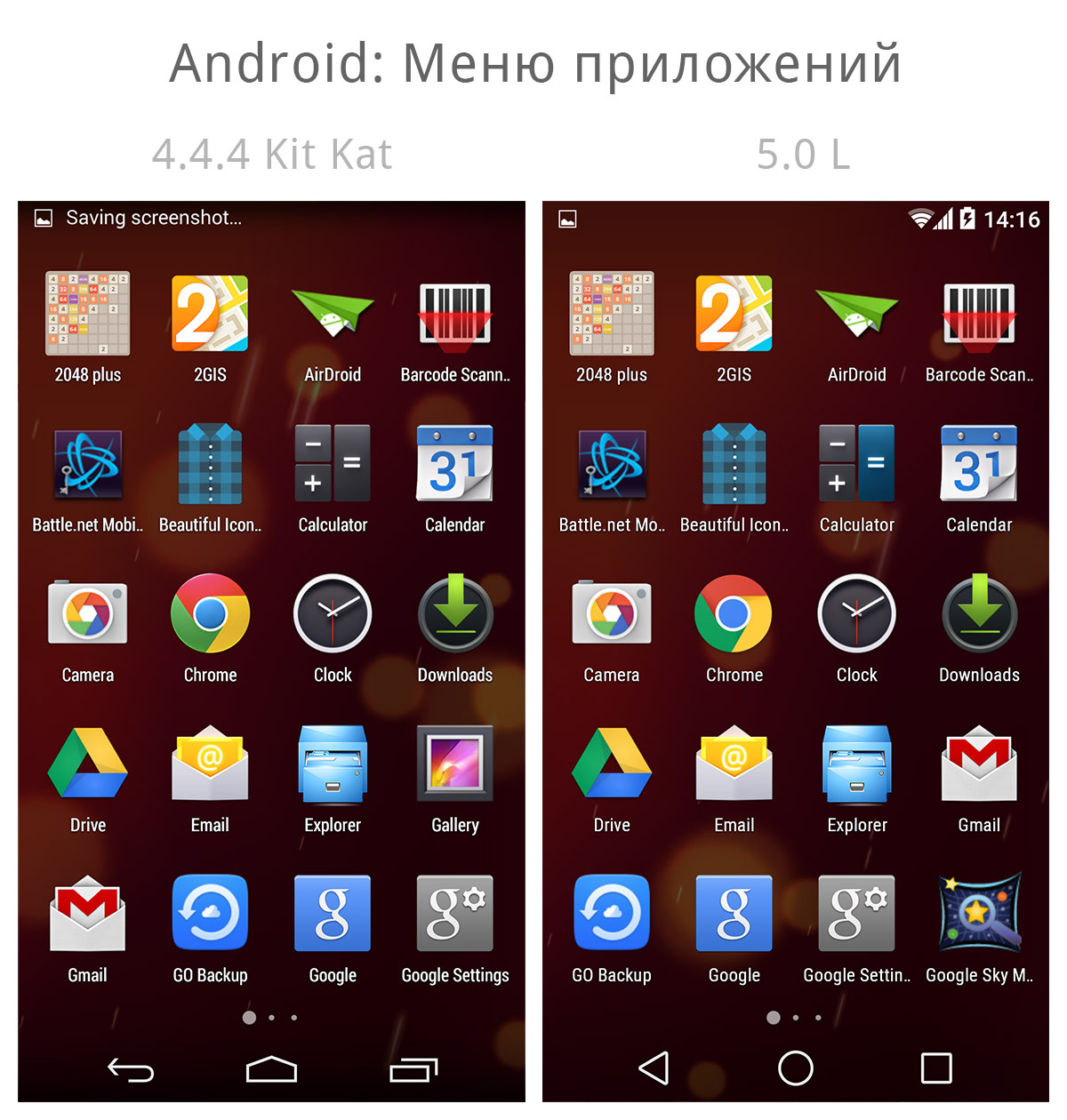
The application menu refers to the launcher, of the changes - only the presence of a bar with icons in notifications.
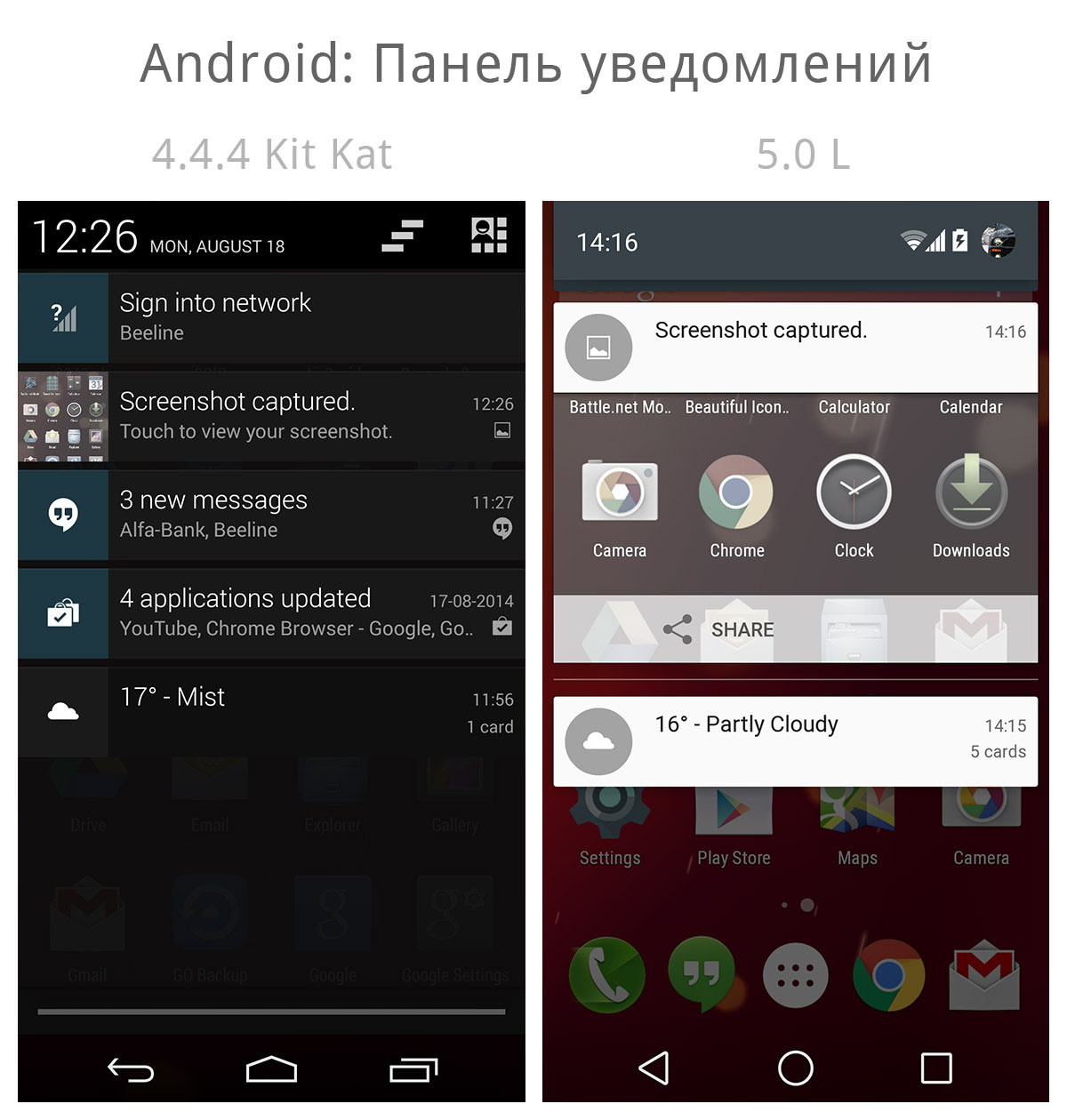
The notification panel has become "cleaner." Large previews, neat "cards". The way to go to the quick settings also differs: on KitKat - the button in the upper right corner, and on Android L you need to make one more swipe down:
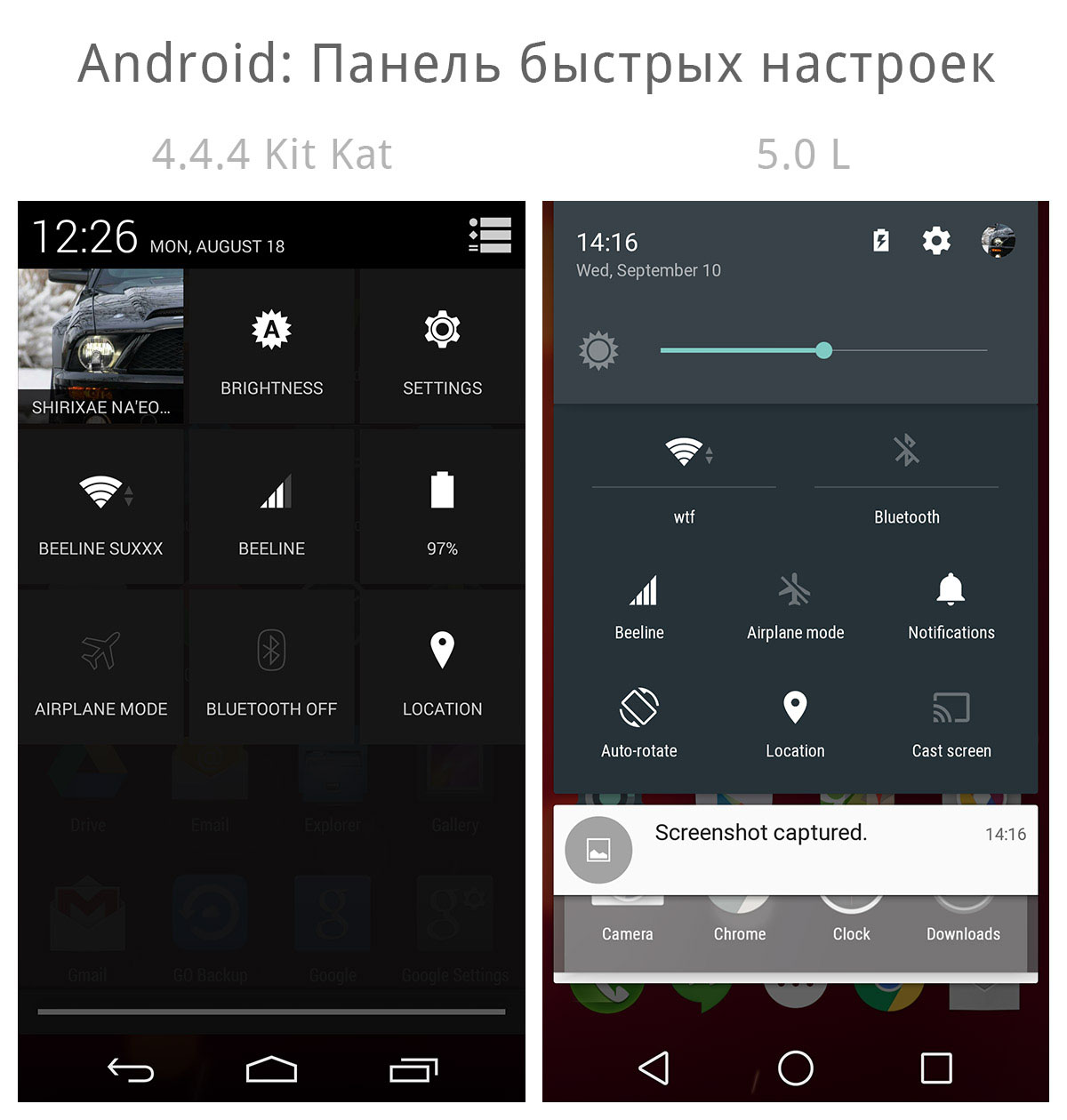
The functionality has not changed, but it looks much more interesting. Hint: to quickly go to the WiFi or BlueTooth settings, click on the caption under the icon. Go to the settings menu of the smartphone itself:
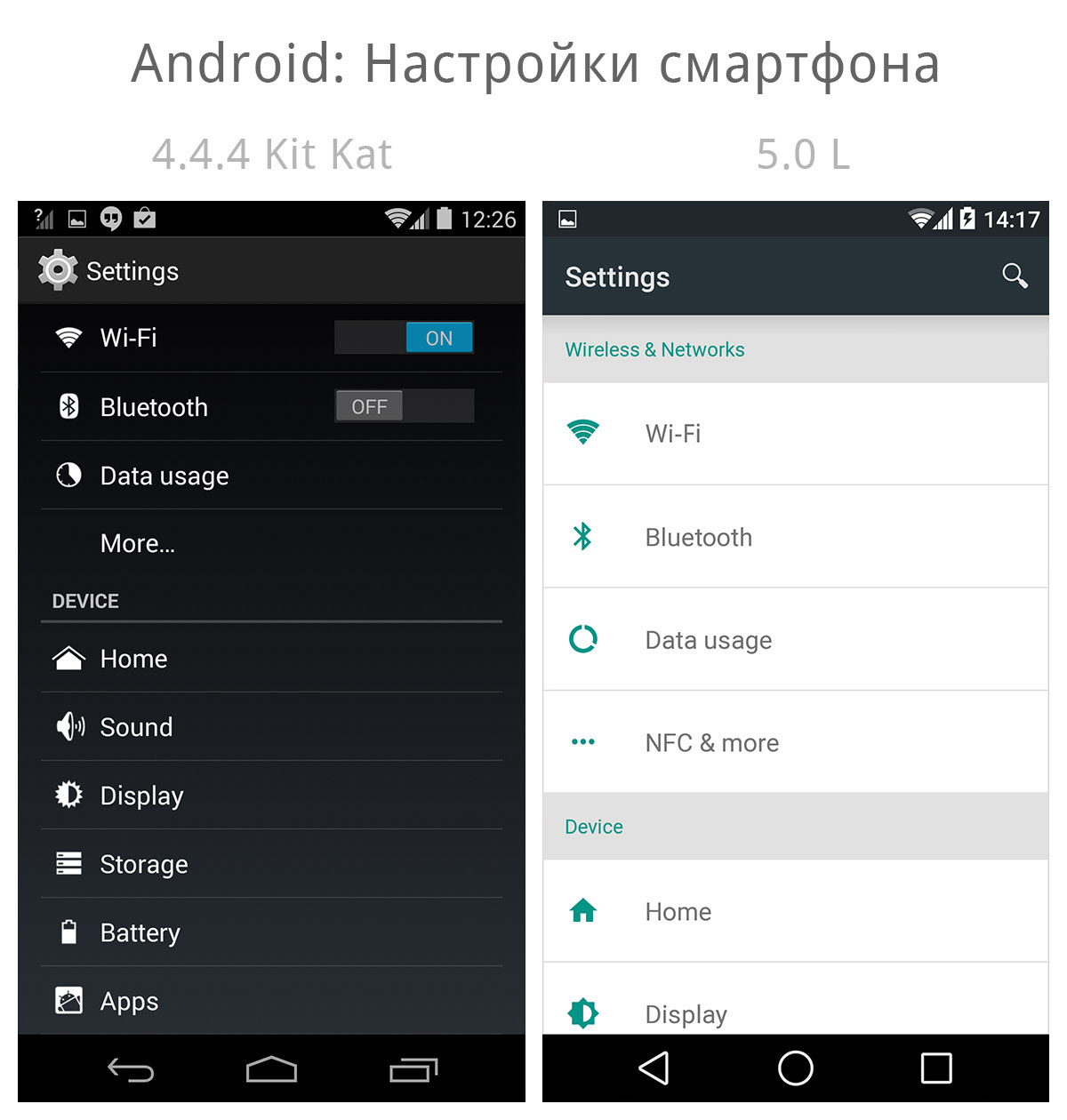
Information density has dropped, the menu looks much lighter (it’s understandable, the color scheme is different). I foresee the whining "now scrolling for half an hour, nafig made more lines, I already saw everything and got it the first time."

Allow me to disagree, lovers of little inscriptions: it became easier to read and find the necessary menu item, but no one died from the scroll. Well and, of course, the Indians "Sharp Eyes" and "Exact Hand", which is important to return "as it was" can easily get their way, we do not have iOS, after all. Inside the settings themselves, the density of information has not suffered:
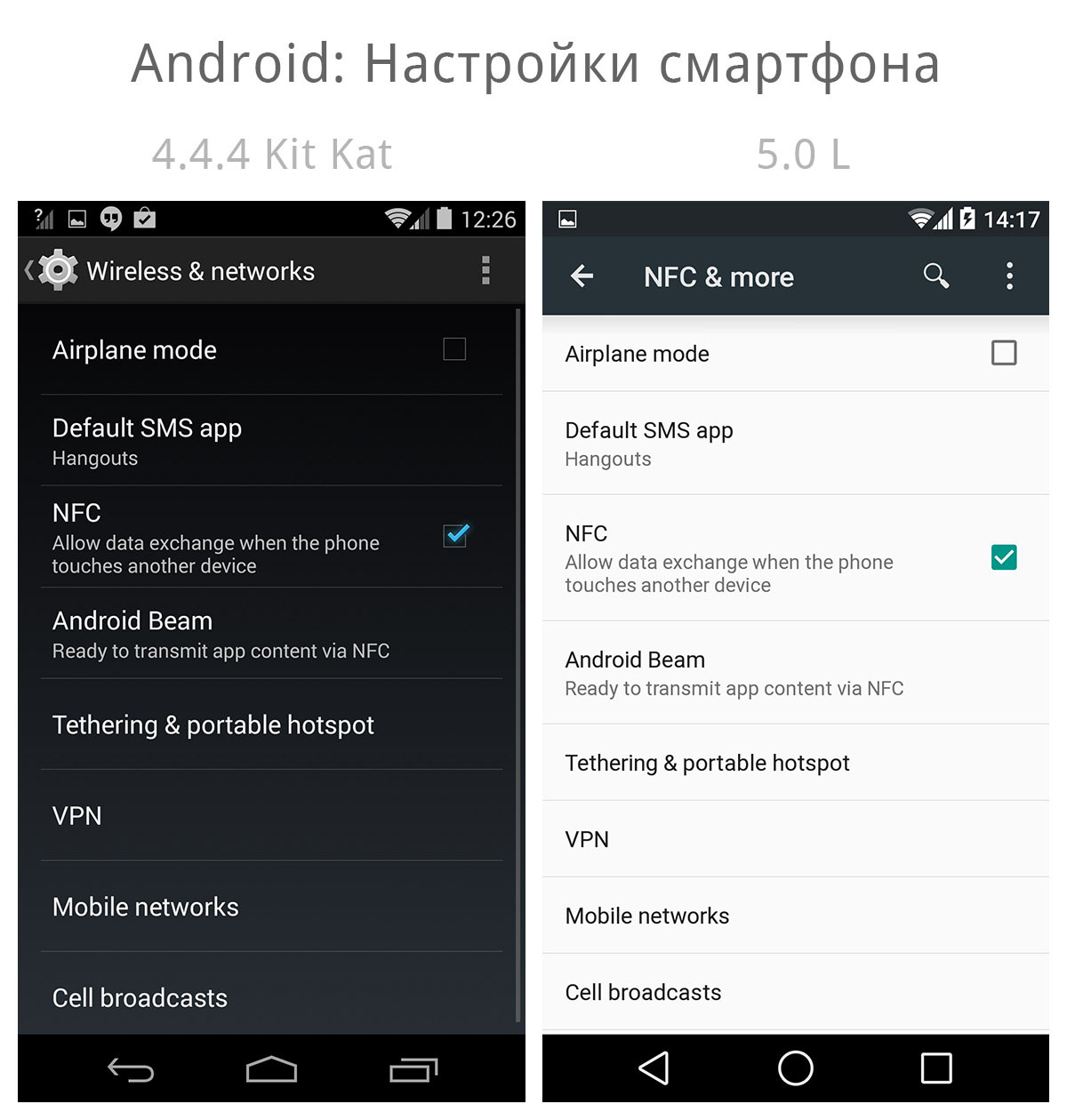
The lines are the same, parity. But, you see, on the right, the interface looks more modern than on the left. It remains only to remove the nasty colors from somewhere:
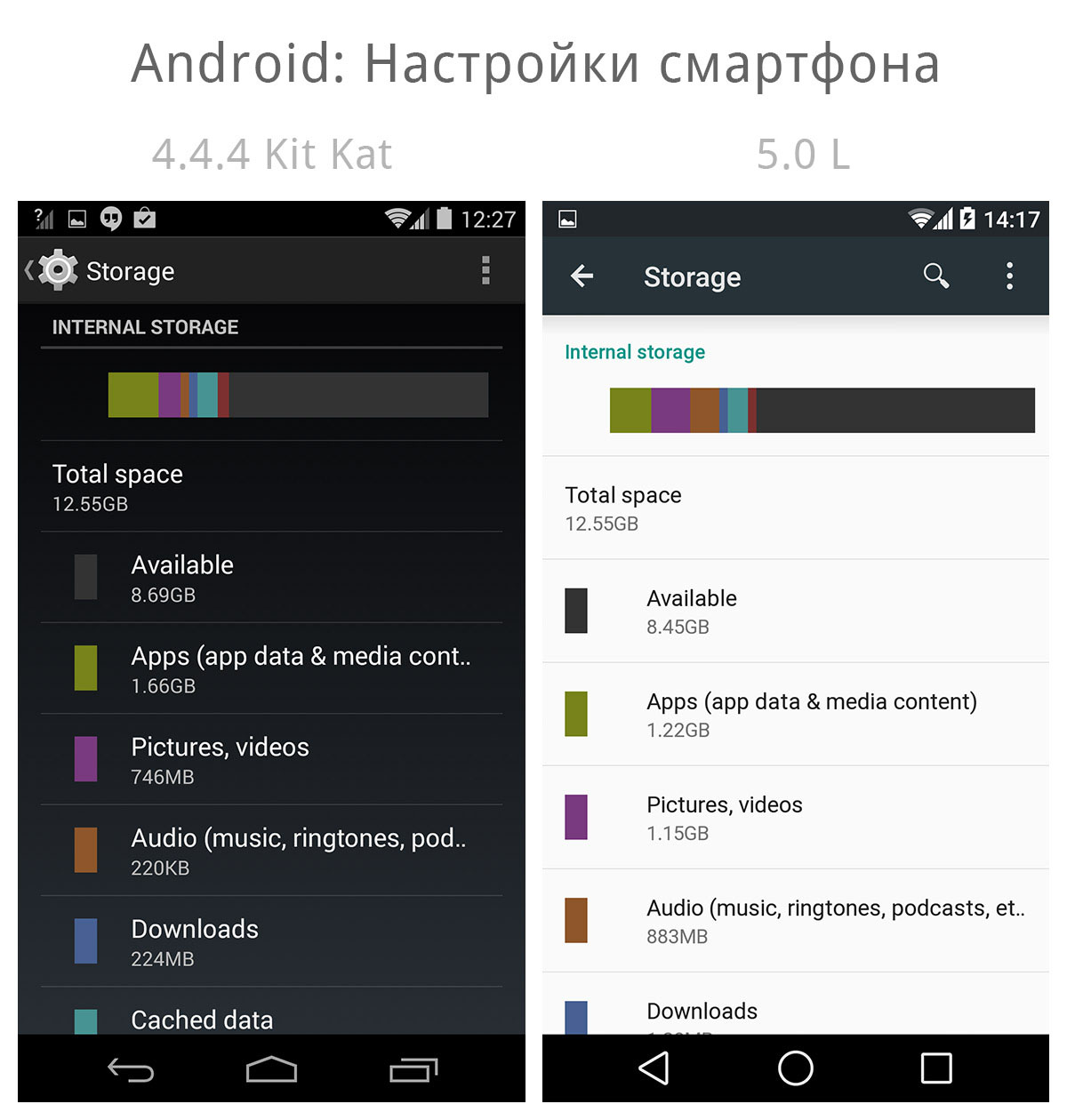
And this strange shit down below to remove. I'm not sure that it is needed as a whole, but I’m still dragging from 2.x if not earlier:
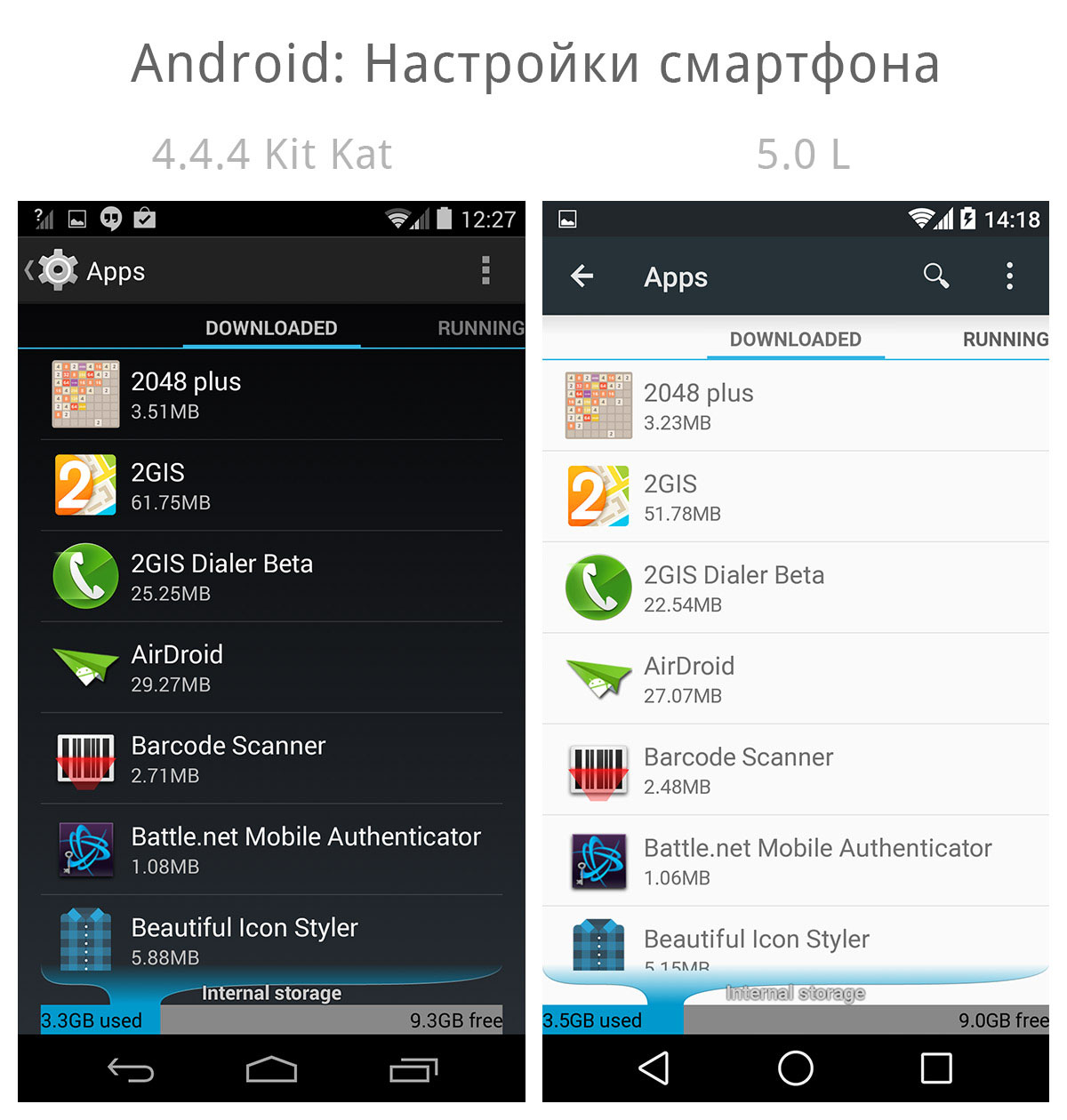
From the shutdown menu, the switches disappeared:

On the one hand, they can be obtained from the notification panel. On the other hand, in all the phones in the shutdown menu there is an airplane mode and a silent mode. However, vendors will certainly return them here. An alternative opinion - the absence is explained by the fact that we have the Developer Preview, and the release will be fixed.

The graphics look prettier. About 111% and NFC do not ask: I do not know how it happened. Developer Preview. Graphs have become more beautiful, but with a small amount of data they look strange:

Nothing has changed in the camera (orientation turned out different, please forgive me).

Incoming calls now do not overlap the entire screen, but hang with a neat panel at the top of the screen:

In addition, Google-software is slowly updated, getting an interface in the style of 5.0. One of the first swallows is Google Chrome:

It's a pity to hook the button, why was it dragged in the menu? :( New mail and other system applications also roam the net, but they will appear as ready-made solutions a bit later.

Desktops almost did not change. On the left (4.4) there is a custom set of some icons, the dialer is not native, but 2Gis. Separately, I want to note the new status icons (in the tray, next to the clock). Look and read much better, because become more contrast. The desktop is Google Start . Swipe your desktop right and go to Google Now:

There are no changes, again: it is understandable, this is a separate application and it looks more or less relevant.

The application menu refers to the launcher, of the changes - only the presence of a bar with icons in notifications.

The notification panel has become "cleaner." Large previews, neat "cards". The way to go to the quick settings also differs: on KitKat - the button in the upper right corner, and on Android L you need to make one more swipe down:

The functionality has not changed, but it looks much more interesting. Hint: to quickly go to the WiFi or BlueTooth settings, click on the caption under the icon. Go to the settings menu of the smartphone itself:

Information density has dropped, the menu looks much lighter (it’s understandable, the color scheme is different). I foresee the whining "now scrolling for half an hour, nafig made more lines, I already saw everything and got it the first time."

Allow me to disagree, lovers of little inscriptions: it became easier to read and find the necessary menu item, but no one died from the scroll. Well and, of course, the Indians "Sharp Eyes" and "Exact Hand", which is important to return "as it was" can easily get their way, we do not have iOS, after all. Inside the settings themselves, the density of information has not suffered:

The lines are the same, parity. But, you see, on the right, the interface looks more modern than on the left. It remains only to remove the nasty colors from somewhere:

And this strange shit down below to remove. I'm not sure that it is needed as a whole, but I’m still dragging from 2.x if not earlier:

From the shutdown menu, the switches disappeared:

On the one hand, they can be obtained from the notification panel. On the other hand, in all the phones in the shutdown menu there is an airplane mode and a silent mode. However, vendors will certainly return them here. An alternative opinion - the absence is explained by the fact that we have the Developer Preview, and the release will be fixed.

The graphics look prettier. About 111% and NFC do not ask: I do not know how it happened. Developer Preview. Graphs have become more beautiful, but with a small amount of data they look strange:

Nothing has changed in the camera (orientation turned out different, please forgive me).

Incoming calls now do not overlap the entire screen, but hang with a neat panel at the top of the screen:

In addition, Google-software is slowly updated, getting an interface in the style of 5.0. One of the first swallows is Google Chrome:

It's a pity to hook the button, why was it dragged in the menu? :( New mail and other system applications also roam the net, but they will appear as ready-made solutions a bit later.
How to put Android L?
In the case of the Nexus 4, everything is quite simple: it rushes easily, custom recovery is installed without problems, there are enough ready-made Android L assemblies on the XDA. I will not give specific references to all of this: who knows how to do this, where to click, and how a drawing tool will find everything better than me. Who does not know - it is better not to meddle without educational program, if you want to try, start reading "what and in what order" is here (open the third spoiler in the first post and study the topic).
In the case of the Nexus 5, things are more complicated. Detailed instructions for installing the official assembly of Android L on the top five are at w3bsit3-dns.com, but, unfortunately, it has links to some of the downloaded materials that are broken. Download the necessary (as well as get English instructions) here , for example.
Separately, I want to note: you yourself take all the risks. Responsibility for damage to your information, your device, its warranty service and the aliens from Alpha Centauri is your responsibility. Neither the author of the post, nor the author of the instructions, nor Google itself is responsible for the wrong Gauss Curvature coefficient of your hands.
Performance and autonomy
The performance of the OS itself is difficult to measure: benchmarks will show a very relative result, moreover, they may differ from measurement to measurement. In an amicable way, it is necessary to observe all lab conditions, that is, to have two devices of each type, place them in identical conditions, carry out a complete cleaning of everything-what-can-and-what-is-impossible, and, on a clean system, ten times, at regular intervals measure the performance of Android 4.4.4 VS Android L, and then swap the OS and perform as many tests to make sure that specific instances of devices do not introduce an error in the measurements. Unfortunately, neither two identical devices, nor such a large amount of personal time yet.
With autonomy, by the way, the same trouble. For this reason, we will measure by the method subjectively: the average wizard case changes little during the week, the quantity and quality of smartphone use by the body is also very constant, so one week with Adnroid 4.4.4, one with Android L, a summary table and the results in it.
Both smartphones were removed from charging at the same time (8 am), both got up at the same time (1 am), each smartphone was used all day as the main and only one. I went with Nexus 4, my favorite woman - with Nexus 5.
The table shows the remaining percentages of charge for the two devices at the time of return to the charger.
Nexus 4:
| Mon | BT | CP | THU | PT | |
| N4, KitKat | 20 | sixteen | 18 | 14 | five |
| N4, L | 18 | nineteen | 20 | 18 | 15 |
| Difference% | -1.8 | 3.16 | 2.18 | 4.14 | 10.05 |
The average difference was 3.546%, which is not much in absolute terms, but it feels like an extra half hour-hour under load in actual operation.
Nexus 5:
| Mon | BT | CP | THU | PT | |
| N5, KitKat | eight | 6 | 12 | ten | 0 |
| N5, L | 14 | 12 | four | 18 | ten |
| Difference% | 6.08 | 6.06 | -7.88 | 8.1 | ten |
The average difference is 4.472%, if it were not for the failure results on Wednesday (rather, they are connected with a large amount of data transfer over 3G and the imperfection of the test procedure itself), the results would have been even better.
Typical use of Nexus 4: up to 10 minutes of talk per day, 1.5-2 hours of music via a Bluetooth connection, 5-10 frames per camera, 10 hours of connecting to Wi-Fi, 2 hours of data transfer via a mobile network, regular email checking, messaging .
Nexus 5 was used more actively: up to 30 minutes of talking, 2 hours of music over the wire, the same 5-10 frames per camera, 10 hours of Wi-Fi, a couple of hours of Mobile Data, constantly active twitter, mail, messengers.
According to the table it is clear that people are too lazy to work on Friday, and the Nexus 5 has reached the charging state in an empty state, which, in principle, is understandable. For the rest, there is a slight increase in autonomy, which, given the general dampness of the updates, which are not just a public beta, but a developer preview, is already a good thing.
You can measure changes in performance only by eye or by shooting synchronous video. For synchronous video, you need two devices of the same model, I, unfortunately, do not have them. As for the "eye": L works much smoother and more pleasant than 4.4 (on which there are no lags and friezes, but there is no such "fluidity" of the interface either). It’s all because of the reworked animations that were previously just ... missing for the most part. If earlier between “clicked” and “appeared” it took ⅛-¼ seconds, then now these ⅛-¼ seconds are busy animating what “appeared”. As with this, L manages to save battery power as well - a mystery. However, we know the answers to it: optimization and ART.
Voice search
One of the most interesting features: Google Now cards and updated Google Search with its speech recognition system. She, of course, is not sinless, but much better than Siri or Cortana: they do not understand Russian at all, and it is not known when they will learn. In this race of outsiders, I personally stand at Cortana: Microsoft is much more attentive to the Russian market than Apple, which can be seen on the cards, on the services, and on the user support. In addition, I have to make an important remark: Google Now is a service of "cards" that gives answers to questions (and sometimes it does before the question was asked). In fact, Now itself is the output system for three infrastructures: Google mail, Google search engine and smartphone applications. Therefore, if I am talking about updating Now, this is not only an update of the service itself, but also related products: voice search, integration of applications into the system, and work with email capabilities.
The last and penultimate Google Voice Search updates brought:
- The ability to continue search queries related to the topic;
- Ability to work with multiple languages simultaneously.
“Is that all?” - you ask. Are you a little?
Firstly, now, finally, almost all the commands related to foreign words work perfectly. Now the Search perfectly understands when asked about the value of shares in Russian, about the value of goods or services of certain companies. Not bad recognizes the addresses of sites that you want to open. Understands phrases like “the nearest Radisson hotel”. Unfortunately, the smartphone has a “feature” speak from my heart: if the smartphone’s English locale is set up, and google now communicates with you in Russian, then some of the answers will be in normal English, the second (like a command to set an alarm clock) is the purest Mutko style "Setting alarm for seven hours and forty minutes in the morning." By the way, I designed a bug report, and they told me that they would deal with the problem soon. It's nice that they answer. Moreover, while I was preparing the post, the smartphone stopped responding to me with an indecent accent and now reports that the task has been completed normally, but you cannot throw the words out of the song.
And secondly - the continuation of search queries - a great thing. You can ask the system what it knows about any famous person, and then ask something like “how old is he” or “who is his wife” or “where was he born”. Pronouns will be replaced with the name and surname of the object you are interested in, and in case you incorrectly compiled a request (for example, asked about the age of a person who has already died), the system will give the correct answer and correct it, reporting the dates of life and age at the time of death. The same applies to requests for “wife” and civil marriage, work with some other aspects of the knowledge graph, which collects the search engine for celebrities. Celebrities, judging by all, are any people about whom there is an article in Wikipedia. :) In addition, the continuation of search queries works not only with people: “What time is it in Petrozavodsk?” -> “What kind of weather is there?” - no problem.
Unfortunately, while the capabilities of the system in Russian are somewhat inferior to those in English, especially in the United States. The penetration of IT-infrastructure into various institutions, and the integration of services, and the presence of much more accumulated knowledge and data, which are used for recognition, also has an effect. More often you will use in Russian -> there will be more data -> it will work better -> faster there will be new buns for our language. Well, of course, report errors (menu - send report), this will greatly simplify the work of voice search engineers. Do not neglect the personalization: just a few days of active work with voice assistant and enabled customization significantly improve the recognition of your voice and your speech.
The full list of commands that the system knows in Russian is quite extensive. I translated their English cheat-sheet into Russian (under the spoiler). Update the Google app (also called “search”), test your voice commands and Google Now, tell in the comments about your experience.
Hidden text

And while we come back to Android L. :)
What to expect owners of low-end devices
I hope to wait for updates. I really hope that vendors will not hang noodles on their ears, that the hardware capabilities will not allow that the screen is too small or the RAM is too tight. For the user, the Nexus 4 doesn’t differ in speed from the Nexus 5, and the modern Moto G budget on the Snapdragon 400 already “In terms of performance, the last year’s flagship, although they cost a half to two times less. And on Nexus 4, everything works great. Well, there’s still hope for the Android One program, you see, after a couple of years, Android will not even get to the bottom of the device’s “non-update”: not the vendor will be responsible for the updates, but the manufacturer of OS, that is, Google. Learn more about One, we learn September 15 .
Considering more voluminous batteries in modern devices and sharpening for a “green” battery in Android L, we will get a quality update, which was a transition from 2.x to 4.x: the smartphone will work faster, longer, and we will cooperate with pleasant , a fresh and neat interface that did not come from an evolutionary way from 2010, but was drawn from scratch in 2014, taking into account the experience gained and current trends. On many screens, the information density decreased, while the speed and convenience increased: legacy forms trailing from Android 2.x gave way to anew drawn, porridge from small lines turned into neat text input fields and explanations for them. The black-gray-blue theme gave way to simple and pleasant colors, full-color fills and the proper focus of the user's attention. So far, some screens, like settings in the depths of the smartphone, parts of the service information and something else are not redrawn, and look somewhat alien, but as soon as you bump into them in the smartphone - you understand how outdated the moral and physical design 4.x: read text harder to work with the interface is not so ... nice or something. As if after Windows 7 or 8 to get into Vista: yes, no longer XP (Android 2.3), but the obsolescence of the interface and concepts is noticeable to the naked eye. In general, progress is felt, the resources of modern smartphones, even in the budget segment, allow you to work with L without any problems, it is up to the manufacturers and suppliers of chipsets.
PS: a huge post came out, notice typos - write in the LAN. Thank! :)
PPS: now, I feel, fans of the “updated and supported” OS will fly in. Comrades, get out of the 3GS box, turn it on, clear all memory and unlock the registry, and then try to make it work without jailbreak. Yes, the OS update itself is wonderful and wonderful (how many features are there from iOS7 / 8 except for redrawn icons, work on iPhone4? 4S?), But in Android devices besides the OS itself there are Google services, and it is their actual version that is important for working device and applications . You can read about it here .
PPPS: at the request of workers, I inform you that not all applications work perfectly with Android L: almost everything related to root and changing system features will work crookedly / will not work at all. Also some clients of social networks and browsers are playing. The explanation for this is one: this is not a release candidate, not a public or closed beta, but a version for developers so that they can begin to adapt their software for the new OS and look at the new design in action.
Source: https://habr.com/ru/post/236395/
All Articles